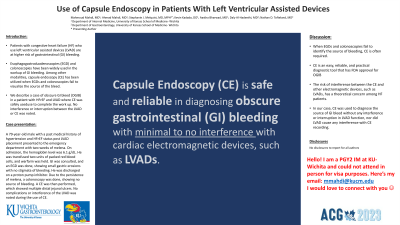Monday Poster Session
Category: GI Bleeding
P2093 - Use of Capsule Endoscopy in Patients With Left Ventricular Assisted Devices
Monday, October 23, 2023
10:30 AM - 4:15 PM PT
Location: Exhibit Hall

Has Audio

Stephanie J. Melquist, MD, MPH
University of Kansas School of Medicine
Wichita, KS
Presenting Author(s)
Mahmoud Mahdi, MD, Ahmad Mahdi, MD, Stephanie J. Melquist, MD, MPH, Kevin Kadado, DO, Aastha Bharwad, MD, Daly Al-Hadeethi, MD, Nathan D. Tofteland, MD
University of Kansas School of Medicine, Wichita, KS
Introduction: Patients with congestive heart failure who use left ventricular assisted devices (LVAD) are at higher risk of gastrointestinal (GI) bleeding. Aggravating factors for bleeding include the use of anti-coagulants, acquired von Willebrand syndrome from shear stress, and arteriovenous malformation caused by reduced pulse pressure and hypoperfusion. Esophagogastroduodenoscopies (EGD) and colonoscopies have been widely used in the workup of GI bleeding. Among other modalities, capsule endoscopy (CE) has been utilized when EGDs and colonoscopies fail to visualize the source of the bleed. CE has been the mainstay of evaluation for obscure GI bleed. With the increase in its use, the question of whether CE affects the functioning of LVADs remains unclear and under investigation.
Case Description/Methods: A 79-year-old male with a past medical history of hypertension and HFrEF status post LVAD placement presented to the Emergency Department with a two-week history of melena. On admission, the hemoglobin level was 6.1 g/dL. He was transfused two units of packed red blood cells, and warfarin was held. GI was consulted, and an EGD was done, showing small gastric erosions with no stigmata of bleeding. He was discharged on a proton pump inhibitor. Due to the persistence of melena, a colonoscopy was done, showing the source of bleeding. A CE was then performed, which showed multiple distal jejunal ulcers. No complications or interference of the LVAD was noted during the use of CE.
Discussion: When EGDs and colonoscopies fail to identify the source of bleeding, CE is often required. CE is a diagnostic tool approved by the FDA in 2001 for its use in the workup of obscure GI bleed (OGIB). CE is an easy, reliable, and practical diagnostic tool for this purpose. A radiofrequency signal is sent to a device the patient wears around their waist. Due to its significant diagnostic yield, CE is widely used, with sensitivity and specificity of 88.9% and 95%, respectively. The risk of interference between the CE and other electromagnetic devices, such as LVADs, has a theoretical concern among HF patients. In our case, CE was used to diagnose the source of GI bleed without any interference or interruption in LVAD function, nor did LVAD cause any interference with CE recording.
Disclosures:
Mahmoud Mahdi, MD, Ahmad Mahdi, MD, Stephanie J. Melquist, MD, MPH, Kevin Kadado, DO, Aastha Bharwad, MD, Daly Al-Hadeethi, MD, Nathan D. Tofteland, MD. P2093 - Use of Capsule Endoscopy in Patients With Left Ventricular Assisted Devices, ACG 2023 Annual Scientific Meeting Abstracts. Vancouver, BC, Canada: American College of Gastroenterology.
University of Kansas School of Medicine, Wichita, KS
Introduction: Patients with congestive heart failure who use left ventricular assisted devices (LVAD) are at higher risk of gastrointestinal (GI) bleeding. Aggravating factors for bleeding include the use of anti-coagulants, acquired von Willebrand syndrome from shear stress, and arteriovenous malformation caused by reduced pulse pressure and hypoperfusion. Esophagogastroduodenoscopies (EGD) and colonoscopies have been widely used in the workup of GI bleeding. Among other modalities, capsule endoscopy (CE) has been utilized when EGDs and colonoscopies fail to visualize the source of the bleed. CE has been the mainstay of evaluation for obscure GI bleed. With the increase in its use, the question of whether CE affects the functioning of LVADs remains unclear and under investigation.
Case Description/Methods: A 79-year-old male with a past medical history of hypertension and HFrEF status post LVAD placement presented to the Emergency Department with a two-week history of melena. On admission, the hemoglobin level was 6.1 g/dL. He was transfused two units of packed red blood cells, and warfarin was held. GI was consulted, and an EGD was done, showing small gastric erosions with no stigmata of bleeding. He was discharged on a proton pump inhibitor. Due to the persistence of melena, a colonoscopy was done, showing the source of bleeding. A CE was then performed, which showed multiple distal jejunal ulcers. No complications or interference of the LVAD was noted during the use of CE.
Discussion: When EGDs and colonoscopies fail to identify the source of bleeding, CE is often required. CE is a diagnostic tool approved by the FDA in 2001 for its use in the workup of obscure GI bleed (OGIB). CE is an easy, reliable, and practical diagnostic tool for this purpose. A radiofrequency signal is sent to a device the patient wears around their waist. Due to its significant diagnostic yield, CE is widely used, with sensitivity and specificity of 88.9% and 95%, respectively. The risk of interference between the CE and other electromagnetic devices, such as LVADs, has a theoretical concern among HF patients. In our case, CE was used to diagnose the source of GI bleed without any interference or interruption in LVAD function, nor did LVAD cause any interference with CE recording.
Disclosures:
Mahmoud Mahdi indicated no relevant financial relationships.
Ahmad Mahdi indicated no relevant financial relationships.
Stephanie Melquist indicated no relevant financial relationships.
Kevin Kadado indicated no relevant financial relationships.
Aastha Bharwad indicated no relevant financial relationships.
Daly Al-Hadeethi indicated no relevant financial relationships.
Nathan Tofteland indicated no relevant financial relationships.
Mahmoud Mahdi, MD, Ahmad Mahdi, MD, Stephanie J. Melquist, MD, MPH, Kevin Kadado, DO, Aastha Bharwad, MD, Daly Al-Hadeethi, MD, Nathan D. Tofteland, MD. P2093 - Use of Capsule Endoscopy in Patients With Left Ventricular Assisted Devices, ACG 2023 Annual Scientific Meeting Abstracts. Vancouver, BC, Canada: American College of Gastroenterology.
